Abstract
Frequency distributions for intracapillary HbO2 saturation were determined for two murine tumour lines (KHT, RIF-1) and two human ovarian carcinoma xenograft lines (MLS, OWI) using a cryospectrophotometric method. The aim was to search for possible relationships between HbO2 saturation status and tumour volume, tumour pH and fraction of radiobiologically hypoxic cells. Tumour pH was measured by 31P NMR spectroscopy. Hypoxic fractions were determined from cell survival curves for tumours irradiated in vivo and assayed in vitro. Tumours in the volume range 100-4000 mm3 were studied and the majority of the vessels were found to have HbO2 saturations below 10%. The volume-dependence of the HbO2 frequency distributions differed significantly among the four tumour lines; HbO2 saturation status decreased with increasing tumour volume for the KHT, RIF-1 and MLS lines and was independent of tumour volume for the OWI line. The data indicated that the rate of decrease in HbO2 saturation status during tumour growth was related to the rate of development of necrosis. The volume-dependence of tumour pH was very similar to that of the HbO2 saturation status for all tumour lines. Significant correlations were therefore found between HbO2 saturation status and tumour pH, both within tumour lines and across the four tumour lines, reflecting that the volume-dependence of both parameters probably was a compulsory consequence of reduced oxygen supply conditions during tumour growth. Hypoxic fraction increased during tumour growth for the KHT, RIF-1 and MLS lines and was volume-independent for the OWI line, suggesting a relationship between HbO2 saturation status and hypoxic fraction within tumour lines. However, there was no correlation between these two parameters across the four tumour lines, indicating that the hypoxic fraction of a tumour is not determined only by the oxygen supply conditions; other parameters may also be important, e.g. oxygen diffusivity, rate of oxygen consumption and cell survival time under hypoxic stress.
Full text
PDF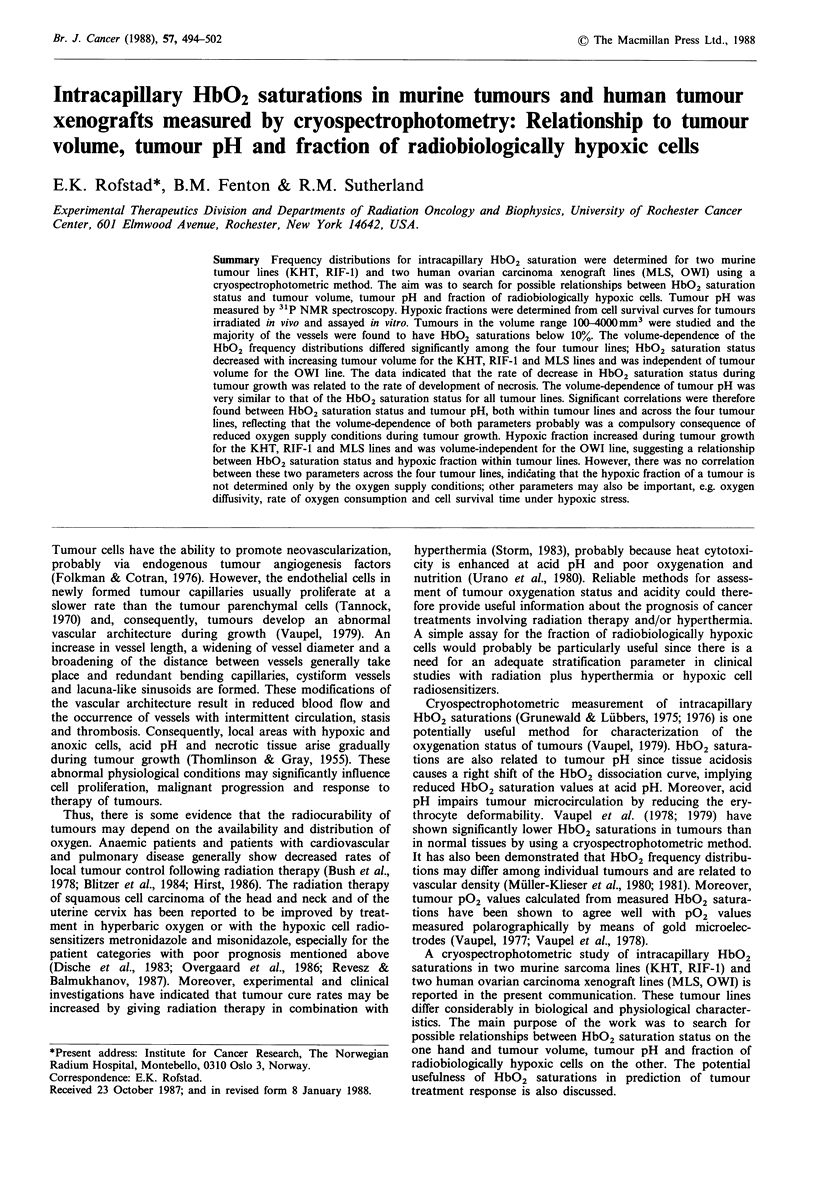
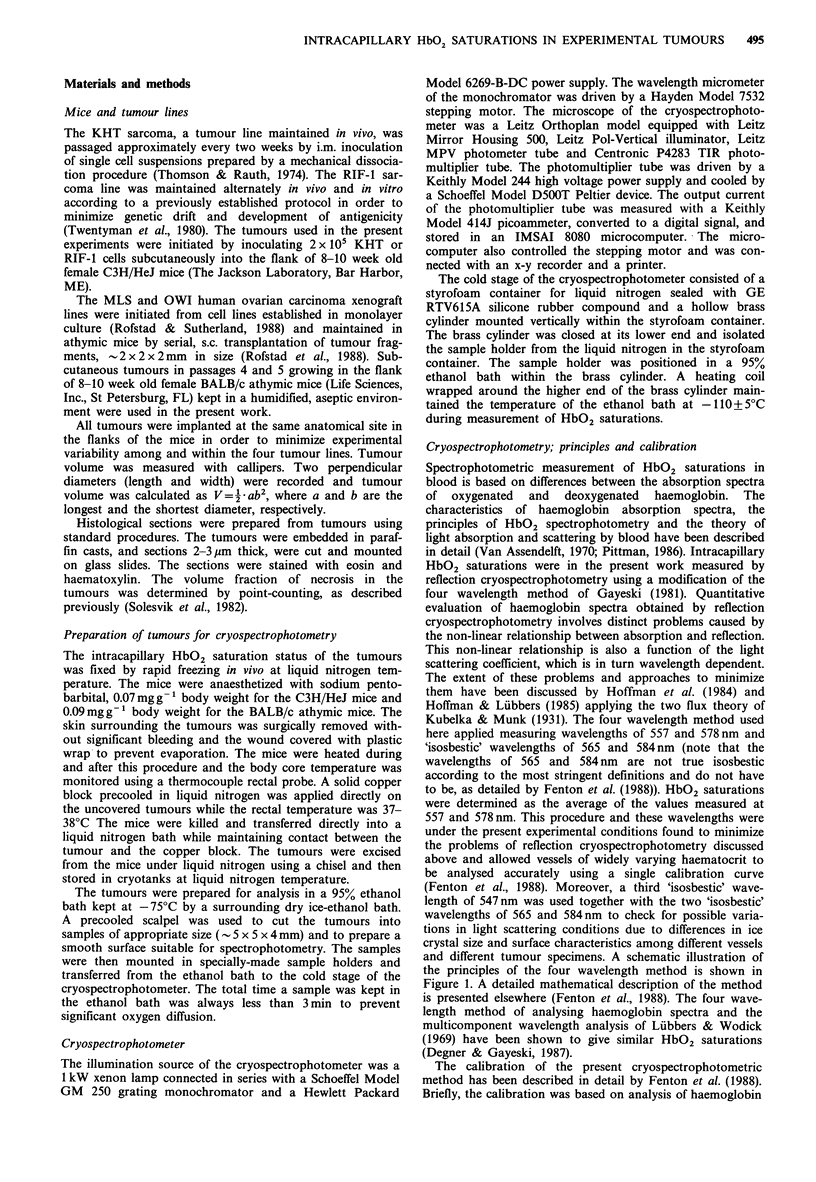
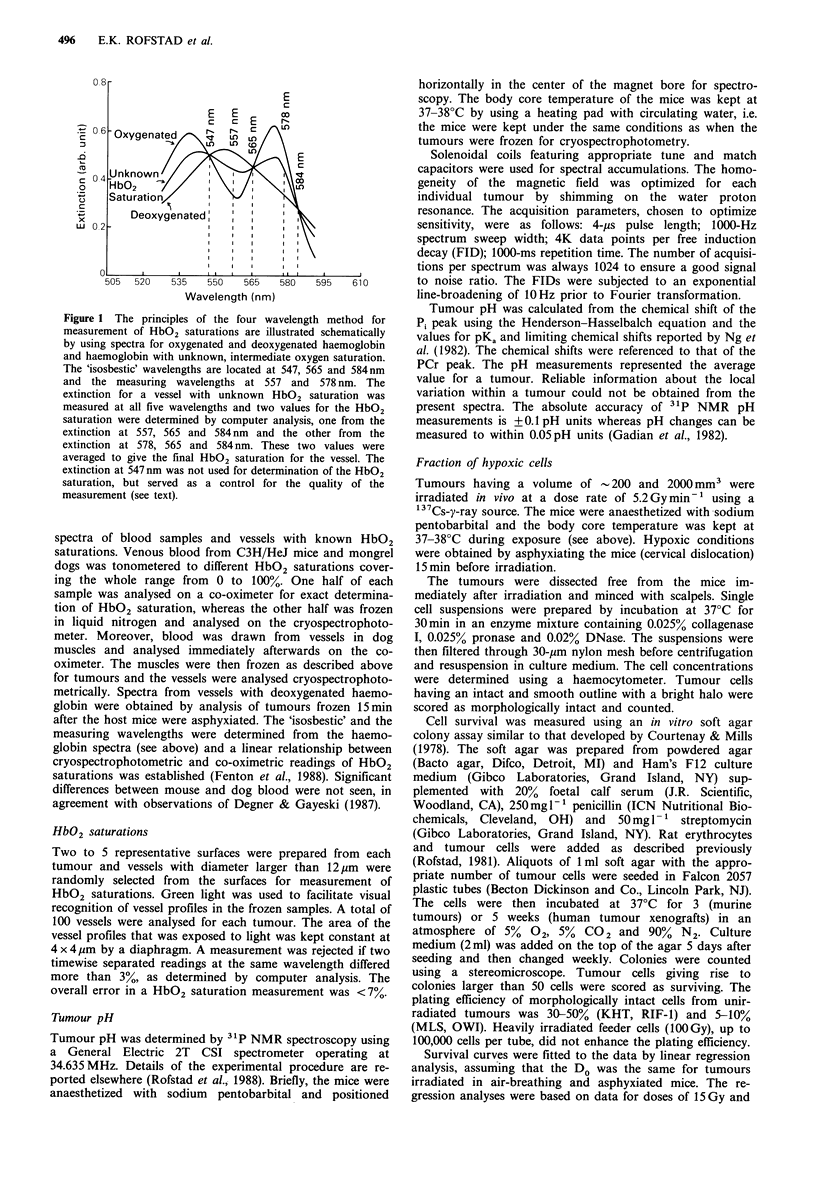

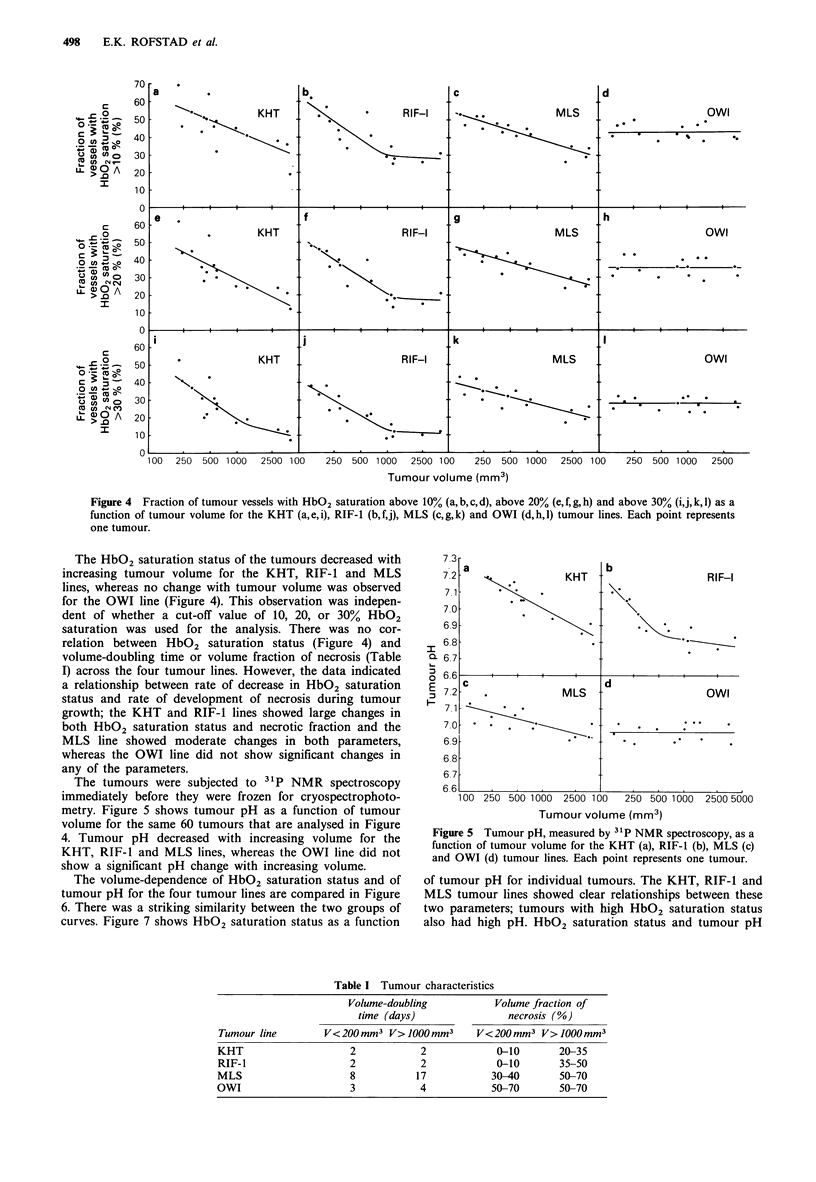
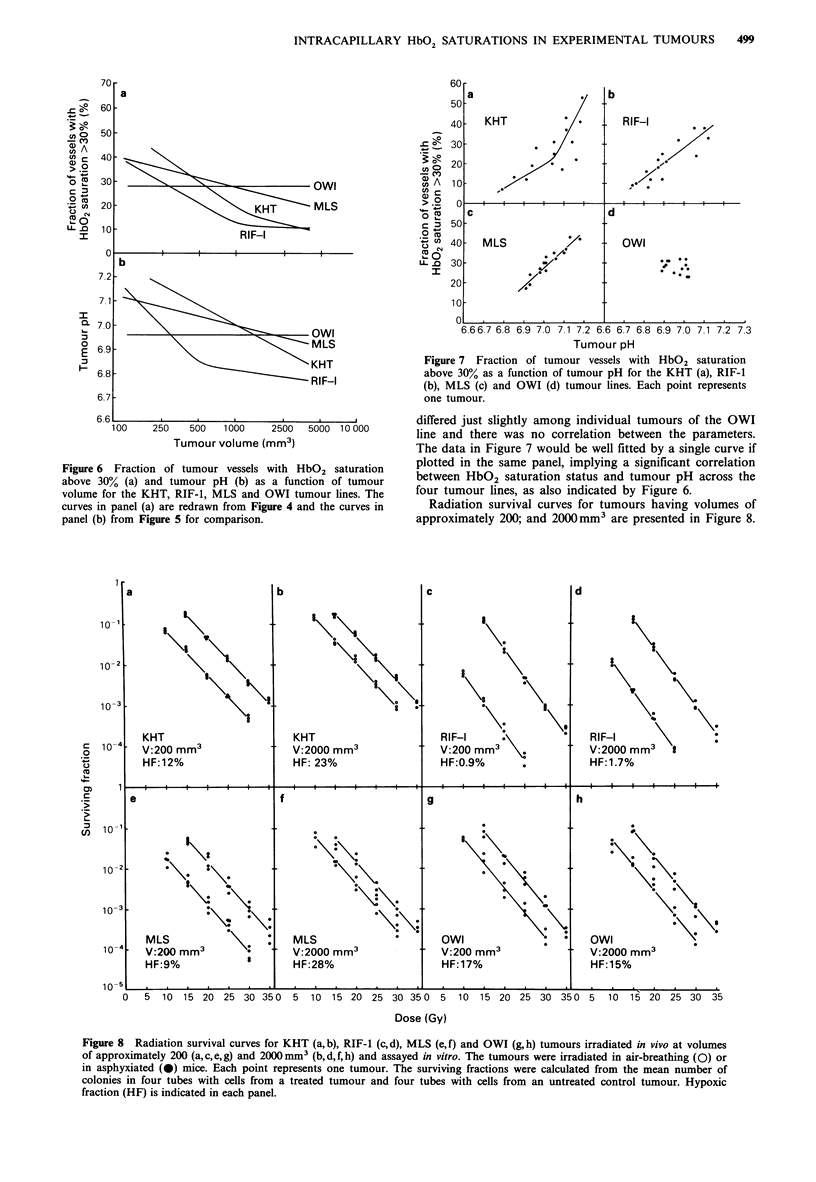
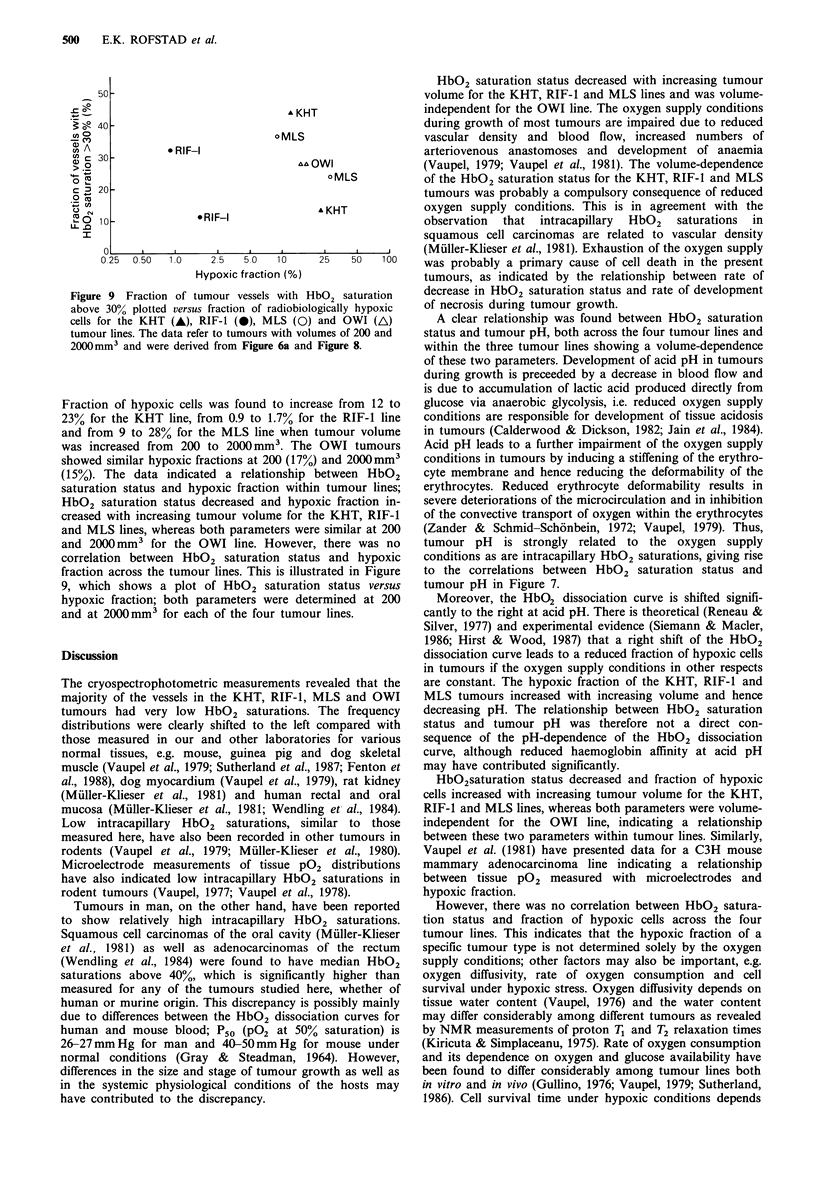
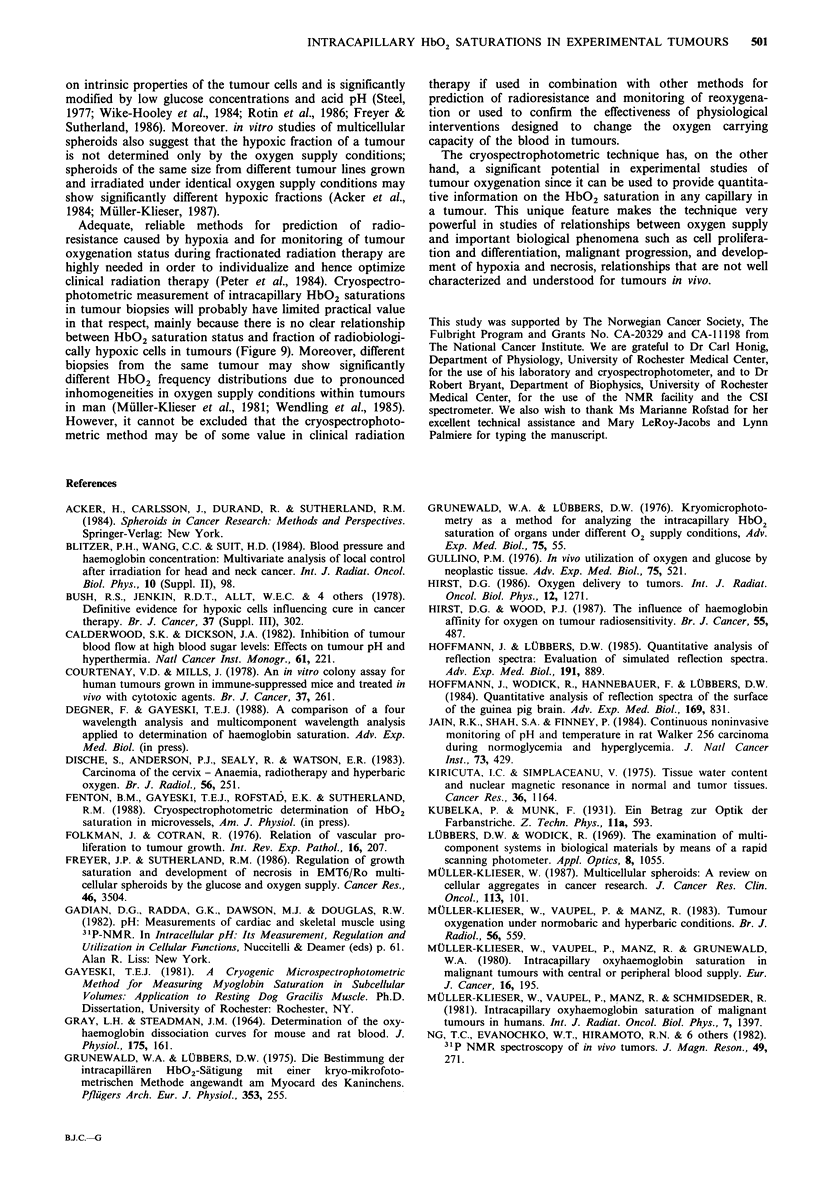

Selected References
These references are in PubMed. This may not be the complete list of references from this article.
- Bush R. S., Jenkin R. D., Allt W. E., Beale F. A., Bean H., Dembo A. J., Pringle J. F. Definitive evidence for hypoxic cells influencing cure in cancer therapy. Br J Cancer Suppl. 1978 Jun;3:302–306. [PMC free article] [PubMed] [Google Scholar]
- Courtenay V. D., Mills J. An in vitro colony assay for human tumours grown in immune-suppressed mice and treated in vivo with cytotoxic agents. Br J Cancer. 1978 Feb;37(2):261–268. doi: 10.1038/bjc.1978.35. [DOI] [PMC free article] [PubMed] [Google Scholar]
- Dische S., Anderson P. J., Sealy R., Watson E. R. Carcinoma of the cervix--anaemia, radiotherapy and hyperbaric oxygen. Br J Radiol. 1983 Apr;56(664):251–255. doi: 10.1259/0007-1285-56-664-251. [DOI] [PubMed] [Google Scholar]
- Folkman J., Cotran R. Relation of vascular proliferation to tumor growth. Int Rev Exp Pathol. 1976;16:207–248. [PubMed] [Google Scholar]
- Freyer J. P., Sutherland R. M. Regulation of growth saturation and development of necrosis in EMT6/Ro multicellular spheroids by the glucose and oxygen supply. Cancer Res. 1986 Jul;46(7):3504–3512. [PubMed] [Google Scholar]
- GRAY L. H., STEADMAN J. M. DETERMINATION OF THE OXYHAEMOGLOBIN DISSOCIATION CURVES FOR MOUSE AND RAT BLOOD. J Physiol. 1964 Dec;175:161–171. doi: 10.1113/jphysiol.1964.sp007509. [DOI] [PMC free article] [PubMed] [Google Scholar]
- Grunewald W. A., Lübbers D. W. Die Bestimmung der intracapillären HbO2-Sättigung mit einer kryo-mikrofotometrischen Methode angewandt am Myokard des Kaninchens. Pflugers Arch. 1975;353(3):255–273. doi: 10.1007/BF00584288. [DOI] [PubMed] [Google Scholar]
- Grunewald W. A., Lübbers D. W. Kryomicrophotometry as a method for analyzing the intracapillary HbO2 saturation of organs under different O2 supply conditions. Adv Exp Med Biol. 1976;75:55–64. doi: 10.1007/978-1-4684-3273-2_8. [DOI] [PubMed] [Google Scholar]
- Gullino P. M. In vivo utilization of oxygen and glucose by neoplastic tissue. Adv Exp Med Biol. 1976;75:521–536. doi: 10.1007/978-1-4684-3273-2_62. [DOI] [PubMed] [Google Scholar]
- Hirst D. G. Oxygen delivery to tumors. Int J Radiat Oncol Biol Phys. 1986 Aug;12(8):1271–1277. doi: 10.1016/0360-3016(86)90152-5. [DOI] [PubMed] [Google Scholar]
- Hirst D. G., Wood P. J. The influence of haemoglobin affinity for oxygen on tumour radiosensitivity. Br J Cancer. 1987 May;55(5):487–491. doi: 10.1038/bjc.1987.99. [DOI] [PMC free article] [PubMed] [Google Scholar]
- Hoffmann J., Lübbers D. W. Quantitative analysis of reflection spectra: evaluation of simulated reflection spectra. Adv Exp Med Biol. 1985;191:889–897. doi: 10.1007/978-1-4684-3291-6_90. [DOI] [PubMed] [Google Scholar]
- Hoffmann J., Wodick R., Hannebauer F., Lübbers D. W. Quantitative analysis of reflection spectra of the surface of the guinea pig brain. Adv Exp Med Biol. 1984;169:831–839. doi: 10.1007/978-1-4684-1188-1_76. [DOI] [PubMed] [Google Scholar]
- Jain R. K., Shah S. A., Finney P. L. Continuous noninvasive monitoring of pH and temperature in rat Walker 256 carcinoma during normoglycemia and hyperglycemia. J Natl Cancer Inst. 1984 Aug;73(2):429–436. doi: 10.1093/jnci/73.2.429. [DOI] [PubMed] [Google Scholar]
- Kiricuta I. C., Jr, Simplăceanu V. Tissue water content and nuclear magnetic resonance in normal and tumor tissues. Cancer Res. 1975 May;35(5):1164–1167. [PubMed] [Google Scholar]
- Mueller-Klieser W. Multicellular spheroids. A review on cellular aggregates in cancer research. J Cancer Res Clin Oncol. 1987;113(2):101–122. doi: 10.1007/BF00391431. [DOI] [PubMed] [Google Scholar]
- Mueller-Klieser W., Vaupel P., Manz R., Schmidseder R. Intracapillary oxyhemoglobin saturation of malignant tumors in humans. Int J Radiat Oncol Biol Phys. 1981 Oct;7(10):1397–1404. doi: 10.1016/0360-3016(81)90036-5. [DOI] [PubMed] [Google Scholar]
- Mueller-Klieser W., Vaupel P., Manz R. Tumour oxygenation under normobaric and hyperbaric conditions. Br J Radiol. 1983 Aug;56(668):559–564. doi: 10.1259/0007-1285-56-668-559. [DOI] [PubMed] [Google Scholar]
- Müller-Klieser W., Vaupel P., Manz R., Grunewald W. A. Intracapillary oxyhemoglobin saturation in malignant tumours with central or peripheral blood supply. Eur J Cancer. 1980 Feb;16(2):195–201. doi: 10.1016/0014-2964(80)90151-6. [DOI] [PubMed] [Google Scholar]
- Overgaard J., Hansen H. S., Jørgensen K., Hjelm Hansen M. Primary radiotherapy of larynx and pharynx carcinoma--an analysis of some factors influencing local control and survival. Int J Radiat Oncol Biol Phys. 1986 Apr;12(4):515–521. doi: 10.1016/0360-3016(86)90058-1. [DOI] [PubMed] [Google Scholar]
- Reneau D. D., Silver I. A. Some effects of high altitude and polycythaemia on oxygen delivery. Adv Exp Med Biol. 1977 Jul 4;94:245–253. doi: 10.1007/978-1-4684-8890-6_34. [DOI] [PubMed] [Google Scholar]
- Rofstad E. K. Radiation response of the cells of a human malignant melanoma xenograft. Effect of hypoxic cell radiosensitizers. Radiat Res. 1981 Sep;87(3):670–683. [PubMed] [Google Scholar]
- Rotin D., Robinson B., Tannock I. F. Influence of hypoxia and an acidic environment on the metabolism and viability of cultured cells: potential implications for cell death in tumors. Cancer Res. 1986 Jun;46(6):2821–2826. [PubMed] [Google Scholar]
- Révész L., Balmukhanov S. B. Anaemia as a prognostic factor for the therapeutic effect of radiosensitizers. Int J Radiat Biol Relat Stud Phys Chem Med. 1987 Apr;51(4):591–595. doi: 10.1080/09553008414552121. [DOI] [PubMed] [Google Scholar]
- Siemann D. W., Macler L. M. Tumor radiosensitization through reductions in hemoglobin affinity. Int J Radiat Oncol Biol Phys. 1986 Aug;12(8):1295–1297. doi: 10.1016/0360-3016(86)90157-4. [DOI] [PubMed] [Google Scholar]
- Solesvik O. V., Rofstad E. K., Brustad T. Vascular structure of five human malignant melanomas grown in athymic nude mice. Br J Cancer. 1982 Oct;46(4):557–567. doi: 10.1038/bjc.1982.240. [DOI] [PMC free article] [PubMed] [Google Scholar]
- Sutherland R. M. Importance of critical metabolites and cellular interactions in the biology of microregions of tumors. Cancer. 1986 Oct 15;58(8):1668–1680. doi: 10.1002/1097-0142(19861015)58:8<1668::aid-cncr2820580816>3.0.co;2-0. [DOI] [PubMed] [Google Scholar]
- THOMLINSON R. H., GRAY L. H. The histological structure of some human lung cancers and the possible implications for radiotherapy. Br J Cancer. 1955 Dec;9(4):539–549. doi: 10.1038/bjc.1955.55. [DOI] [PMC free article] [PubMed] [Google Scholar]
- Tannock I. F. Population kinetics of carcinoma cells, capillary endothelial cells, and fibroblasts in a transplanted mouse mammary tumor. Cancer Res. 1970 Oct;30(10):2470–2476. [PubMed] [Google Scholar]
- Thomson J. E., Rauth A. M. An in vitro assay to measure the viability of KHT tumor cells not previously exposed to culture conditions. Radiat Res. 1974 May;58(2):262–276. [PubMed] [Google Scholar]
- Urano M., Gerweck L. E., Epstein R., Cunningham M., Suit H. D. Response of a spontaneous murine tumor to hyperthermia: factors which modify the thermal response in vivo. Radiat Res. 1980 Aug;83(2):312–322. [PubMed] [Google Scholar]
- Vaupel P. W., Frinak S., Bicher H. I. Heterogeneous oxygen partial pressure and pH distribution in C3H mouse mammary adenocarcinoma. Cancer Res. 1981 May;41(5):2008–2013. [PubMed] [Google Scholar]
- Vaupel P. Effect of percentual water content in tissues and liquids on the diffusion coefficients of O2, CO2, N2, and H2. Pflugers Arch. 1976 Jan 30;361(2):201–204. doi: 10.1007/BF00583467. [DOI] [PubMed] [Google Scholar]
- Vaupel P., Grunewald W. A., Manz R., Sowa W. Intracapillary HbO2 saturation in tumor tissue of DS-carcinosarcoma during normoxia. Adv Exp Med Biol. 1977 Jul 4;94:367–375. doi: 10.1007/978-1-4684-8890-6_48. [DOI] [PubMed] [Google Scholar]
- Vaupel P. Hypoxia in neoplastic tissue. Microvasc Res. 1977 May;13(3):399–408. doi: 10.1016/0026-2862(77)90106-6. [DOI] [PubMed] [Google Scholar]
- Vaupel P., Manz R., Müller-Klieser W., Grunewald W. A. Intracapillary HbO2 saturation in malignant tumors during normoxia and hyperoxia. Microvasc Res. 1979 Mar;17(2):181–191. doi: 10.1016/0026-2862(79)90405-9. [DOI] [PubMed] [Google Scholar]
- Wendling P., Manz R., Thews G., Vaupel P. Heterogeneous oxygenation of rectal carcinomas in humans: a critical parameter for preoperative irradiation? Adv Exp Med Biol. 1984;180:293–300. doi: 10.1007/978-1-4684-4895-5_28. [DOI] [PubMed] [Google Scholar]
- Wike-Hooley J. L., Haveman J., Reinhold H. S. The relevance of tumour pH to the treatment of malignant disease. Radiother Oncol. 1984 Dec;2(4):343–366. doi: 10.1016/s0167-8140(84)80077-8. [DOI] [PubMed] [Google Scholar]
- Zander R., Schmid-Schönbein H. Influence of intracellular convection on the oxygen release by human erythrocytes. Pflugers Arch. 1972;335(1):58–73. doi: 10.1007/BF00586935. [DOI] [PubMed] [Google Scholar]


